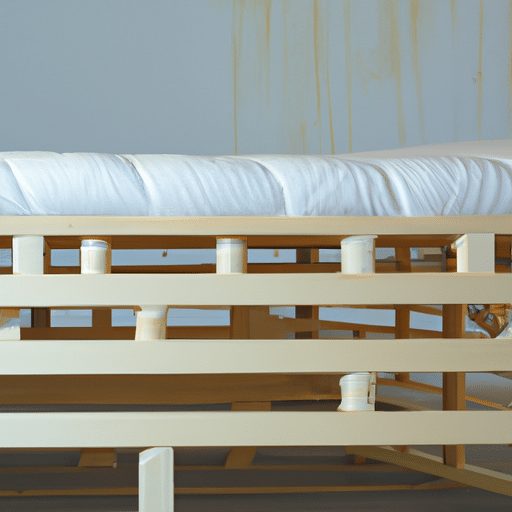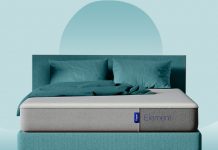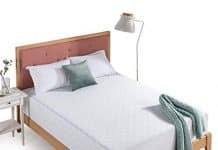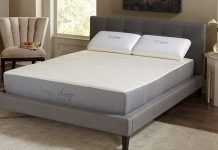Thinking about getting a new mattress but not sure if it will work on your existing bed frame? We’re here to help ease your uncertainty! In this article, we’ll address the age-old question: Will a mattress work on slats or require a box spring? Whether you have a bed frame with slats or a traditional box spring, we’ll explore the pros and cons of each option, so you can make an informed decision that suits your comfort preferences and sleep needs. Get ready to sleep soundly knowing that your mattress is perfectly paired with the right support system!
Review contents
Benefits of Using Slats
Improved Airflow
One of the key benefits of using slats as a mattress support system is improved airflow. Slats provide a breathable surface for your mattress, allowing air to circulate underneath. This helps to regulate temperature and prevent the buildup of moisture, which can lead to the growth of mold and mildew. By promoting airflow, slats can contribute to a healthier sleep environment and enhance the longevity of your mattress.
Adjustable Support
Slats offer the advantage of adjustable support, allowing you to customize the firmness of your sleep surface. By choosing slats with varying thickness or adjusting their placement, you can tailor the support to your specific preferences. This flexibility is especially beneficial for couples with different comfort preferences or individuals who experience changes in their sleep needs over time.
Cost-effectiveness
Using slats as a mattress support system can be a more cost-effective option compared to purchasing a traditional box spring. Slats are generally less expensive than box springs, making them an attractive choice for those on a budget. Additionally, slats are often included as a standard component in many bed frames, saving you the extra expense of purchasing a separate support system.
Considerations for Using Slats
Quality and Thickness of Slats
When using slats as a mattress support system, it is important to consider the quality and thickness of the slats. Thin or poorly constructed slats may not provide adequate support and can lead to sagging or discomfort. Opt for slats that are made of durable materials, such as hardwood, and ensure that they are thick enough to distribute weight evenly across the mattress.
Spacing between Slats
Another crucial consideration when using slats is the spacing between them. The ideal spacing will depend on the type of mattress you have. For foam or latex mattresses, slats should be spaced closer together to provide sufficient support. Generally, a spacing of 2-3 inches between slats is recommended to prevent sagging and promote mattress longevity.
Slats for Foam or Latex Mattresses
If you have a foam or latex mattress, it is essential to choose slats specifically designed for these types of mattresses. Foam and latex mattresses require more evenly distributed support to ensure optimal comfort and prevent sagging. Look for slats that have additional support legs or a solid surface to provide the necessary stability and prevent the mattress from sinking between the slats.
Benefits of Using Box Springs
Extra Height and Support
One of the primary advantages of using box springs is the additional height they provide to your bed. Box springs typically add several inches of height, which can make it easier to get in and out of bed, especially for individuals with mobility issues. The extra height can also enhance the overall aesthetic of your bedroom, giving your bed a more substantial and luxurious appearance.
In addition to height, box springs also offer enhanced support for your mattress. They act as a shock absorber, absorbing the pressure and movement applied to the mattress. This can help extend the lifespan of your mattress by reducing wear and tear, as well as provide a more comfortable sleeping surface.
Shock Absorption
Box springs excel in absorbing shocks and impact, making them an excellent choice for individuals who are more prone to movement during sleep or those who frequently change sleep positions. With the ability to distribute weight evenly, box springs help to minimize motion transfer, ensuring that any movement on one side of the bed does not disturb the other sleeper. This is especially beneficial for couples sharing a bed, as it promotes undisturbed sleep.
Uniform Mattress Support
Box springs provide uniform support to the entire mattress, regardless of the mattress type. This is especially important for mattresses with uneven or sagging areas, as the box spring can help compensate for these irregularities. By providing consistent support, box springs help to maintain the integrity of the mattress and prevent premature sagging or deformations.
Considerations for Using Box Springs
Compatibility with Mattress Type
While box springs offer numerous benefits, it is crucial to consider whether they are compatible with your specific mattress type. Not all mattresses are designed to be used with box springs. For example, memory foam mattresses are better supported by a solid foundation or platform bed. Consult the manufacturer’s recommendations or contact customer service to ensure that using a box spring is suitable for your specific mattress.
Durability of Box Springs
When selecting a box spring, consider its durability and long-term performance. Look for box springs made of sturdy materials, such as wood or steel, as these tend to be more durable and provide better support. Additionally, consider the weight and quality of the mattress you plan to use with the box spring. Heavier mattresses may require a more robust box spring to prevent sagging or damage.
Cost and Space Constraints
Box springs can be a more expensive option compared to slats or alternative support systems. If you are on a tighter budget, a box spring may not be the most cost-effective choice. Furthermore, box springs can be bulkier and may require more significant storage space, especially if they are not used with a bed frame that incorporates storage options. Ensure that you have enough space in your bedroom for the box spring and consider alternative support systems if space is limited.
Alternatives to Box Springs
Platform Beds
If you prefer a sleek and modern look for your bedroom, a platform bed may be the perfect alternative to a box spring. Platform beds feature a solid base or a slatted surface that provides consistent support for your mattress. They eliminate the need for a box spring and often include built-in storage options, making them a practical choice for smaller spaces. Platform beds are compatible with various mattress types and offer stability and durability comparable to box springs.
Adjustable Bases
For those seeking ultimate comfort and customization, adjustable bases are an excellent alternative to both slats and box springs. These bases allow you to adjust the position of your mattress, offering multiple ergonomic positions for reading, watching TV, or sleeping. Adjustable bases often come with additional features like massage functions and remote control operation, providing a luxurious sleep experience. Keep in mind that adjustable bases may require specific mattress types that are compatible with their movement and flexibility.
Solid Foundations
Solid foundations, also known as bunkie boards or plywood platforms, are another alternative to box springs. These foundations consist of a flat, solid surface that provides consistent support for your mattress. Solid foundations are ideal for foam or latex mattresses, as they offer the necessary stability and prevent the mattress from sinking between slats. They are also a space-saving option for smaller bedrooms, as they do not add significant height to the bed.
Choosing the Right Support System
When it comes to selecting the right support system for your mattress, several factors should be considered.
Mattress Type and Manufacturer Recommendations
Start by referring to the mattress manufacturer’s recommendations. They will provide specific guidelines on the type of support system that is best suited for your mattress. Some mattresses may require a box spring, while others may be designed to work with slats or other alternative support systems. Following the manufacturer’s recommendations will ensure that you provide the appropriate support for your mattress and maintain its warranty.
Personal Preferences and Comfort
Consider your personal preferences and comfort needs. If you prefer a higher bed height or require extra support for easier access, a box spring may be the better option for you. On the other hand, if you prioritize breathability and adjustability, slats or alternative support systems like platform beds or adjustable bases may be more suitable. Ultimately, choose a support system that aligns with your individual sleep preferences and promotes a comfortable night’s rest.
Bed Frame and Design
The bed frame you choose can also influence the type of support system you opt for. Some bed frames are specifically designed to accommodate box springs, while others are equipped with built-in slats or solid platforms. Consider the design and compatibility of your bed frame with different support systems. If you plan to switch between support systems in the future, ensure that your bed frame can accommodate those changes without the need for additional modifications.
Factors to Consider for Mattress Support
Weight Distribution and Body Types
Different support systems can affect weight distribution and body types. Slats with minimal spacing may cause excess pressure on certain areas of the mattress, while box springs or solid foundations provide more even weight distribution across the mattress surface. Consider your body type, weight, and any specific pressure points when choosing a support system. Opt for a system that provides adequate support and allows for proper spinal alignment and pressure relief.
Noise and Motion Isolation
For individuals sharing a bed, noise and motion isolation can be significant factors to consider. Slats, especially if they are not secure or have significant spacing, can produce squeaking or creaking sounds when weight is applied. Box springs, on the other hand, tend to provide better motion isolation and reduce noise transfer. If you are easily disturbed by movement or noise during sleep, consider a support system that offers better motion isolation, such as box springs or solid foundations.
Durability and Longevity
Evaluate the durability and longevity of your chosen support system. Slats made of low-quality materials or lacking proper support legs may sag or break over time, compromising the support and comfort of your mattress. Box springs and solid foundations made of durable materials and designed to withstand the weight and stress of a mattress offer greater longevity. Consider the materials used in the construction of your support system and opt for high-quality components to ensure lasting performance.
Maintaining Mattress Support
To ensure the longevity and performance of your chosen support system, proper maintenance is essential. Here are some tips for maintaining mattress support:
Regular Cleaning and Maintenance
Regularly clean and vacuum the area around and underneath your mattress to prevent the accumulation of dust and debris. This will help promote airflow and keep your support system in optimal condition.
Inspecting Slats or Box Springs
Periodically inspect the slats or box springs for any signs of wear, damage, or sagging. Ensure that slats are securely in place and do not show signs of bending or cracking. For box springs, check the overall structural integrity and ensure that there are no broken or loose springs. Promptly address any issues to prevent further damage and maintain the support system’s effectiveness.
Replacing Worn-out Components
If you notice any significant wear or damage to your support system, it may be necessary to replace worn-out components. This is especially important for slats that have become warped or box springs with broken or worn-out springs. Replacing damaged or worn-out components will help restore the support and comfort of your mattress, prolonging its lifespan.
Common Questions About Slats and Box Springs
Can I Use Slats with a Memory Foam Mattress?
Yes, slats can be used with a memory foam mattress, but it is essential to choose slats specifically designed for this type of mattress. Memory foam mattresses require more even support to prevent sagging. Look for slats that have minimal spacing and additional support legs or a solid surface to provide proper stability and prevent the mattress from sinking between the slats.
Do I Need a Box Spring with a Platform Bed?
No, a box spring is not necessary when using a platform bed. Platform beds have a solid base or slatted surface that provides sufficient support for the mattress. The combination of the platform bed and mattress eliminates the need for a box spring. Platform beds offer a sleek and modern look while providing the necessary support and stability for your mattress.
Are Adjustable Bases Suitable for All Mattresses?
Adjustable bases can be used with various mattress types, but it is crucial to check the compatibility before investing in an adjustable base. Some mattresses, such as certain innerspring or hybrid mattresses, may not be suitable for use with adjustable bases due to their construction or materials. Memory foam and latex mattresses are typically the most compatible with adjustable bases, as they can flex and contour to the base’s movement.
Conclusion
When it comes to supporting your mattress, there are several options to consider. Slats, box springs, platform beds, adjustable bases, and solid foundations each offer their own set of benefits and considerations. By carefully evaluating your specific mattress type, personal preferences, and budget, you can choose the right support system that promotes a comfortable and restful night’s sleep. Regular maintenance and proper care will help ensure the longevity and effectiveness of your chosen support system, allowing you to enjoy the full benefits of your mattress for years to come.































